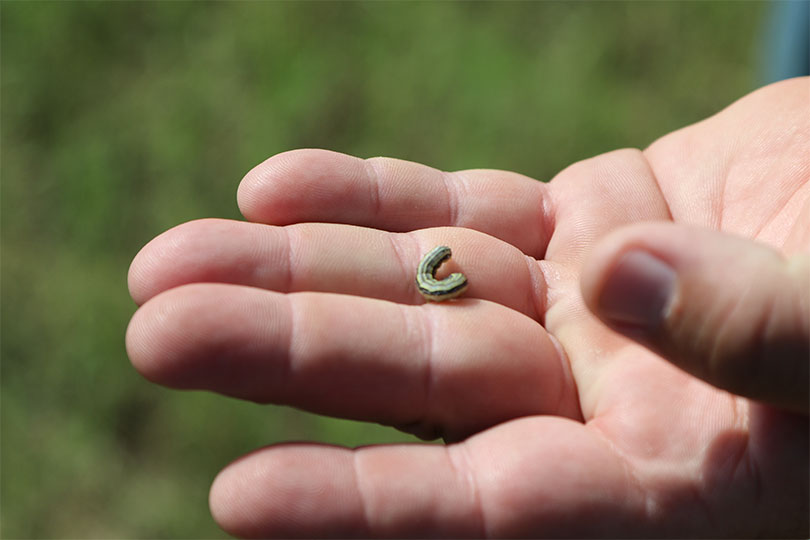By Jennifer Dorsett
Field Editor
Armyworms can devastate crops, hayfields and pastures, but a Texas A&M University graduate student is researching the tiny pests in hopes of finding new control methods.
Ashley Tessnow, who is studying entomology and pursuing her doctoral degree, was awarded a $51,574 grant from the U.S. Department of Agriculture (USDA) National Institute of Food and Agriculture to study genomic differences in fall armyworm populations.
Although farmers and ranchers have battled armyworms for years, Tessnow said experts don’t really understand much about them.
“There have been increased occurrences of major armyworm outbreaks over the past few years,” she said. “And armyworms have also made it into news because they were introduced to Africa, Asia and Australia. With this increased attention, we have come to realize how little we actually know about them.”
Each year, fall armyworms winter in South Texas, then migrate north through the central U.S. and into Canada. They migrate in the adult moth form, but it’s the larval life stage of the insect as armyworms that do the most damage, devouring foliage and killing grasses and crops alike.
The armyworm is named for the way the pests work their way across fields, leaving plant death and destruction in their wake.
Tessnow’s research is rooted in two distinct strains of fall armyworms. They’re visually identical but have genetic variants. She will be studying the C-strain, named for its prevalence in corn fields, and the R-strain, which is often found in rice fields. The R-strain is also primarily responsible for Bermudagrass and other small grass damages.
Both strains have different crop preferences and react to insecticides differently, according to Tessnow. She said they can also hybridize, creating a third variant of fall armyworm.
The USDA-funded research will focus on using genetic sequencing methods to identify armyworm populations in regions of Texas and the U.S. and to determine how frequently they interact and hybridize.
Through her research, Tessnow hopes to develop new genomic tools to control armyworm infestations based on the strain.
“We’ll be looking at genetic differences between these strains and any instances of hybridization as the moths migrate from south to north every year,” she said. “We have preliminary data that shows the same populations of armyworms can be found from Weslaco to Minnesota, but we want to study the genomic structure and how these strains differ.”
She also hopes to develop new diagnostic tools to easily differentiate the pests, which could possibly identify new ways of managing each strain separately or together.
“When collecting moths in corn and sorghum fields, which are expected to be primarily comprised of C-strain fall armyworms, we’ve found there is actually an even mix of both strains,” she said. “So, we want to understand the relationship between strains, what is causing them to be genetically distinct and look for patterns of hybridization. We know hybridization occurs between strains at relatively low rates, but we don’t know how this may affect the fall armyworm’s susceptibility to insecticides, including Bt crops.”
Tessnow placed moth traps in corn or sorghum fields in Weslaco, Corpus Christi, College Station and Lubbock, as well as in Rosemount, Minnesota. She plans to collect a minimum of 25 moths from each location several times a year.
Sequencing DNA from 20 individual specimens from each location will be uploaded into a high-powered computing system. Bioinformation analyses will differentiate the two strains, as well as any hybrids.
The sequenced data can then be used to identify subpopulations between different locations. Tessnow noted the DNA sequencing will be made available for other researchers after the project’s completion.
“We’re most interested in the prevalence of these two strains in the field and what crops they prefer,” she said. “But I am also curious how the misconception that all fall armyworms in a field are the same strain might be affecting mitigation programs for this pest. Knowing which armyworm strain we’re dealing with, and how common it is to have both strains present at specific locations, could impact the effectiveness of treating those crops for fall armyworms.”

